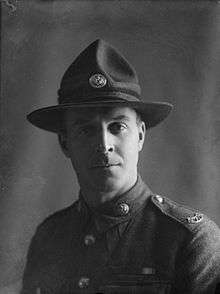James Crichton (VC)
| James Crichton | |
|---|---|
 Private James Crichton c.1918–19 | |
| Nickname(s) | "Scotty"[1] |
| Born |
15 July 1879 Carrickfergus, County Antrim, Ireland |
| Died |
22 September 1961 (aged 82) Takapuna, New Zealand |
| Allegiance |
United Kingdom New Zealand |
| Service/branch |
British Army New Zealand Military Forces |
| Years of service |
1899–1904 1914–19 |
| Rank | Sergeant |
| Unit | 2nd Battalion, Auckland Infantry Regiment |
| Battles/wars |
Second Boer War |
| Awards | Victoria Cross |
James Crichton, VC (15 July 1879 – 22 September 1961) was an Irish-born soldier and a recipient of the Victoria Cross (VC), the highest award for gallantry in the face of the enemy that can be awarded to British and Commonwealth forces. He served with the British Army during the Second Boer War, and later emigrated to New Zealand. Following the outbreak of the First World War, he joined the New Zealand Military Forces and was awarded the VC for his actions during the Hundred Days Offensive.
Early life
Crichton was born in Carrickfergus, Ireland on 15 July 1879.[2] He served with the Cameron Highlanders for five years, including in a period in South Africa during the Second Boer War, before moving to New Zealand. He settled in Auckland and worked as a cable splicer.[3]
First World War
Following the outbreak of the First World War, Crichton volunteered for the New Zealand Military Forces and was sent to the Middle East with the New Zealand Expeditionary Force. He was attached to the Army Service Corps as a baker in the 1st Field Bakery and served at Gallipoli and on the Western Front.[4] In May 1918, harbouring a desire to serve with the infantry, he relinquished his rank as a warrant officer and transferred to the 2nd Battalion, Auckland Infantry Regiment with the rank of private.[2]
During the Hundred Days Offensive, on 30 September 1918, Crichton's platoon was trying to force a crossing of the Scheldt River, near Crèvecœur, when it came under machine-gun fire. He was wounded and his platoon commander and senior non-commissioned officer were killed. Crichton was awarded the Victoria Cross (VC) for his subsequent deeds. The citation for his VC read:
For most conspicuous bravery and devotion to duty when, although wounded in the foot, he continued with the advancing troops despite difficult canal and river obstacles. When his platoon was subsequently forced back by a counterattack he succeeded in carrying a message which involved swimming a river and crossing an area swept by machine-gun fire, subsequently rejoining his platoon. Later he undertook on his own initiative to save a bridge which had been mined, and, though under close fire of machine-guns and snipers, he succeeded in removing the charges, returning with the fuses and detonators. Though suffering from a painful wound he displayed the highest degree of valour and devotion to duty.— The London Gazette, No. 31012, 15 November 1918[5]
_1919_(Art.IWM_ART_1923).jpg)
After he returned to his company commander to report his successful deactivation of the demolition charges, Crichton attempted to return to his platoon but was ordered to remain behind at company headquarters. Crichton then assisted stretcher bearers carrying wounded before the gravity of his wounds became apparent and he was taken, despite his protests, to a field hospital.[2] Later promoted to sergeant, he was still recovering from his wounds when the war ended.[3] His VC was the last to be won by a serviceman of the NZEF during the First World War.[4]
Later life
Crichton was discharged from the NZEF in September 1919. His wounds were such that he was considered unsuitable for active service. On his return to New Zealand he resumed his pre-war profession as a cable splicer. He was part of the New Zealand contingent sent to London in 1937 for the coronation of King George VI and Queen Elizabeth. He died at Takapuna on 22 September 1961, and is buried in Waikumete Cemetery in Auckland.[6]
After his death, Crichton's family donated his Victoria Cross to the Auckland War Memorial Museum.[6]
Notes
- ↑ Gliddon 2000, p. 69.
- 1 2 3 Harper & Richardson 2007, p. 173.
- 1 2 McGibbon 2000, p. 128.
- 1 2 Harper & Richardson 2007, p. 172.
- ↑ The London Gazette: (Supplement) no. 31012. p. 13474. 12 November 1918. Retrieved 5 May 2015.
- 1 2 Harper & Richardson 2007, p. 174.
References
- Gliddon, Gerald (2000). The Final Days 1918. VCs of the First World War. Stroud, Gloucestershire: Sutton Publishing. ISBN 0-7509-2485-3.
- Harper, Glyn; Richardson, Colin (2007). In the Face of the Enemy: The Complete History of the Victoria Cross and New Zealand. Auckland, New Zealand: HarperCollins. ISBN 1869506502.
- McGibbon, Ian, ed. (2000). The Oxford Companion to New Zealand Military History. Auckland, New Zealand: Oxford University Press. ISBN 0-19-558376-0.